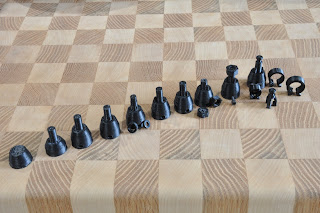
The first approach used was to design 3D drawing of the spool connector in blender (blender.org), then use a MakerBot (makerbot.com) to fabricate the part. In the first photo (left to right), blender was used until an attempt was made to add threads to the top of the connector shaft. This was necessary in order to secure the film spool to the connector shaft with a nut. However, even though this problem can be solved in blender, I come to the realization that a computer-aided design (CAD) program would be more appropriate.
Starting on the 6th spool connector (first photo left-to-right), LibreCAD (librecad.org) and OpenSCAD (openscad.org) was used. To re-accomplish the same work from blender, it took 5 minutes to complete a 2D draft in LibreCAD, and 20 minutes in OpenSCAD. Each additional draft in OpenSCAD was exported to an .stl file (STL files describe only the surface geometry of a three dimensional object). ReplicatorG 0025 (replicat.org) was then used to convert each draft to g-code. G-code is the common name for the most widely used computer numerical control (CNC) programming language, and in my case, the MakerBot.
The second and third photographs show the completed product. Two spool connectors were generated: one with a threaded shaft and nut (secure but take longer), and the other with a notched shaft and clip (faster but less secure).


This part was created by using only open source hardware and software: Ubuntu (similar to Microsoft Windows and MacOS), gimp (similar to Adobe Photoshop), blender (similar to Autodesk Maya), ReplicatorG, LibreCAD and OpenSCAD (simular to AutoCAD), and MakerBot.

No comments:
Post a Comment